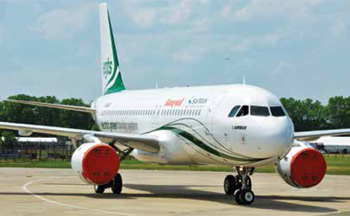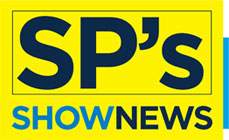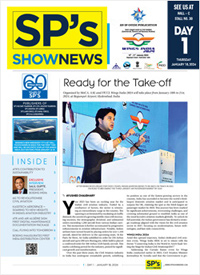- Prime Minister Narendra Modi inaugurates Aero India 2023 in Bengaluru; Releases Commemorative Stamp
- Defence Secretary meets delegations from Saudi Arabia, USA and Oman on the sidelines of Aero India 2023
- Foreign Ministers of 32 countries to attend Aero India 2023
- Embraer showcases the C-390 Millennium at Aero India 2023
Honeywell, Safran sign up GoAir for electric taxiing system

Honeywell and Safran have signed a memorandum of understanding (MoU) with GoAir, one of India’s leading low-cost carriers, to support the advancement of the EGTS electric taxiing system, a technology that can save airlines up to four per cent block fuel consumption per flight.
GoAir becomes the fourth airline in the world after Air France, Easy- Jet, and TUIfly. Sasi Kancharla, Customer Business Leader, Air Transport and Regional Aerospace, India, Honeywell said, the system was likely to go to market in the next few years and would benefit single aisle, narrow body and regional aircraft.
EGTS uses electric motors on the main landing gear to enable the aircraft to push back autonomously and taxi without using its main engines to improve operational efficiency and reduce emissions. The news follows an agreement with Airbus in December to jointly evaluate EGTS as an option for the company’s A320 family of airplanes.
“At GoAir, we are constantly looking for innovative ways to lower costs for our passengers while improving their flying experience at the same time,” said Giorgio De Roni, CEO, GoAir. “This agreement allows us to actively participate in the system’s development - a technology that we believe has the potential to not only save fuel and reduce costs, but also improve aircraft turnaround times and lower noise and emissions in the airport environment.”
Under the agreement, GoAir will provide data on its taxiing operations to Honeywell and Safran to assist in maturing the system and to define the precise fuel and other operational benefits it would see by using the technology across its fleets. The agreement will also see GoAir assist in establishing the airline standard operational procedures for aircraft equipped with the system.
“Where EGTS comes into its own is in supporting high-volume, fast-turnaround, short-haul movements, where aircraft spend a large proportion of the day on the tarmac taxiing,” said Brian Wenig, vice president EGTS Program, Honeywell Aerospace. “As the only electric taxiing system to receive support from a major OEM to date, EGTS represents an exciting, cost-effective technology for airlines to lower their fuel burn and save money.”
Since the technology’s “first move” last April on board the joint venture’s A320 test aircraft, EGTS has logged more than 200 kilometres of rolling tests, including various load configurations and runway conditions, complex maneuvers such as pushback, tight turns and U-turns, and varying specifications of acceleration and speed up to maximum takeoff weight.
“EGTS has a significant benefit over other systems in that it has a maingear- based electric taxiing design,” said Olivier Savin, vice president EGTS Program, Safran. “Consequently, EGTS is the only onboard system currently in development that can generate enough traction to mitigate the use of engines during taxiing in all weather conditions and at all airports.”





